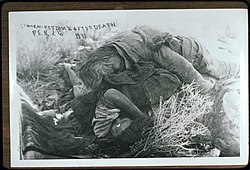



Mike Daggett, original Shoshoni name Ondongarte[1] (died February 25, 1911), was a Shoshone man who is best known for his involvement in the Battle of Kelley Creek, during which he was killed with several members of his family.[2] Daggett was also known by many other names, including "Shoshone Mike" (only after his death),[3] "Indian Mike," "Rock Creek Mike," and "Salmon River Mike."[4]
Background[edit]
Daggett fathered twelve to thirteen children and is first recorded in history in 1890 when he and his family were removed from their lands on Fort Hall Indian Reservation in Idaho by settlers who claimed they had purchased the land. Twenty years later, in the spring of 1910, Daggett led his family off the reservation and they traveled to Nevada and California where they worked at various jobs.
Cattle theft[edit]
Finally, in January 1911, the Daggetts were encamped in Little High Rock Canyon in Washoe County, Nevada. Their winter stores were running low so Mike decided to steal and slaughter some cattle belonging to a local rancher.
Death and legacy[edit]
The theft did not go unnoticed and a posse of four men went to the canyon to deal with the situation, but when the four entered, Mike and two of his oldest sons ambushed the posse and killed all of them on January 19. The bodies were later found mutilated and piled in a creek bed[5] by a search party on February 8, after which a posse of Nevada and California policemen and citizens was sent to apprehend the Daggett party. On February 25, 1911, the posse discovered Mike Daggett and his followers at a place known as Kelley Creek in Humboldt County, Nevada. During a battle that lasted three hours, Mike was killed, along with seven others, and four of his children were taken into police custody. The four later attended Stewart Indian School near Carson City, Nevada, but three died because of illness; by 1913 only one, Daggett's baby granddaughter, was still alive, renamed Mary Jo Estep.[4][6][7] She died in 1992.[3] The remains of the dead were buried near Golconda, Nevada. Eventually, the remains were donated by a local rancher to the Smithsonian Institution. In 1994 the remains were repatriated to the Fort Hall Idaho Shoshone-Bannock Tribe.[8]
References[edit]
- ^ Bergon, Frank (December 1, 1987). "Shaping the Past: The search for Shoshone Mike". Vassar Quarterly. LXXXIV (1): 16–19. Retrieved April 27, 2021.
- ^ Mullen Jr., Frank X. (February 19, 2011). "Shoshone Mike: New theories emerge 100 years after 'last massacre' (part 1)". Reno Gazette-Journal. Retrieved April 22, 2020.
- ^ a b Mullen Jr., Frank X. (February 19, 2011). "Shoshone Mike: New theories emerge 100 years after 'last massacre' (part 2)". Reno Gazette-Journal. Retrieved April 22, 2020.
- ^ a b Hickson, Howard. "Last Indian Uprising? Shoshone Mike, February 26, 1911". Great Basin College. Retrieved 2015-01-24.
- ^ Mack, Effie Mona (1968). The Indian Massacre of 1911 at Little High Rock Canyon, Nevada. p. 26. Retrieved January 7, 2022.
- ^ Washoe County Sheriff's Office: Dedicated Service in Partnership with Our Community. Turner Publishing. 2004. pp. 19–20. ISBN 9781563119545. Retrieved April 22, 2020.
- ^ Rhoads, Becky Carr (2011-11-03). "Shoshone Indian Girl Visits Casey; Last Survivor Of Tribe". Lincoln Trail Publishing. Archived from the original on 2015-01-23. Retrieved 2015-01-24.
- ^ "Repatriation Office Case Report Summaries, Great Basin Region" (PDF). Smithsonian Institution, National Museum of Natural History. 2020.